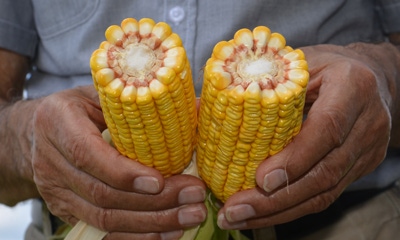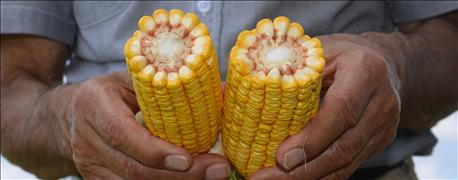September 28, 2016

What factors determine whether you will deliver 56-pound test-weight No. 1 yellow corn, or 54-pound test-weight No. 2 yellow corn when you haul grain to the elevator? Some negative factors could drive test weight even lower than 54 pounds per acre.
Here are six key factors:
1. Hybrid selection matters. Planting hybrids with genetic potential for higher test weight will generally yield grain with higher test weight if kernels are fully mature. However, that doesn’t necessarily mean yield will be higher.

HYBRID DIFFERENCES AFFECT TEST WEIGHT: Note that kernels are deeper on the ear on the right than the other ear. Genetics play a big role in determining kernel shape and size.
2. All other things being equal, planting date can affect test weight. Early planting helps hybrid maturity and leads to higher test weight. Studies for several years have shown that earlier-planted corn had 1 to 1.5 pounds higher test weight per bushel than corn from the same hybrids but later plantings.
3. Grain moisture comes into play. Lower grain moisture means higher test weight since kernel dry matter is heavier than water. Drier grain shrinks and has higher test weight because you can pack more dry kernels into a bushel basket.
4. Stress can be bad news for test weight. Heat and drought stress tend to decrease test weight because they affect the photosynthetic process and reduce kernel weight. In this case, they also reduce yield.
5. Leaf diseases can be another negative factor. Late-season leaf diseases like anthracnose, gray leaf spot, northern and southern corn leaf blights, and southern rust can drastically affect test weight. Depending upon when they become severe, they can interrupt grain fill and proper grain development.
6. Ear rots also work against test weights. Ear rot diseases like diplodia, gibberella or aspergillus will have a negative effect on test weight. Select hybrids with tolerance to these pathogens in seed companies’ demo plots and your own test plots. Diplodia and gibberella are more likely this year, since they’re favored by warmer, damp weather. Aspergillus shows up more in dry years.
Nanda is president of Agronomic Crops Consultants LLC. Email him at [email protected], or call him at 317-910-9876.
You May Also Like




